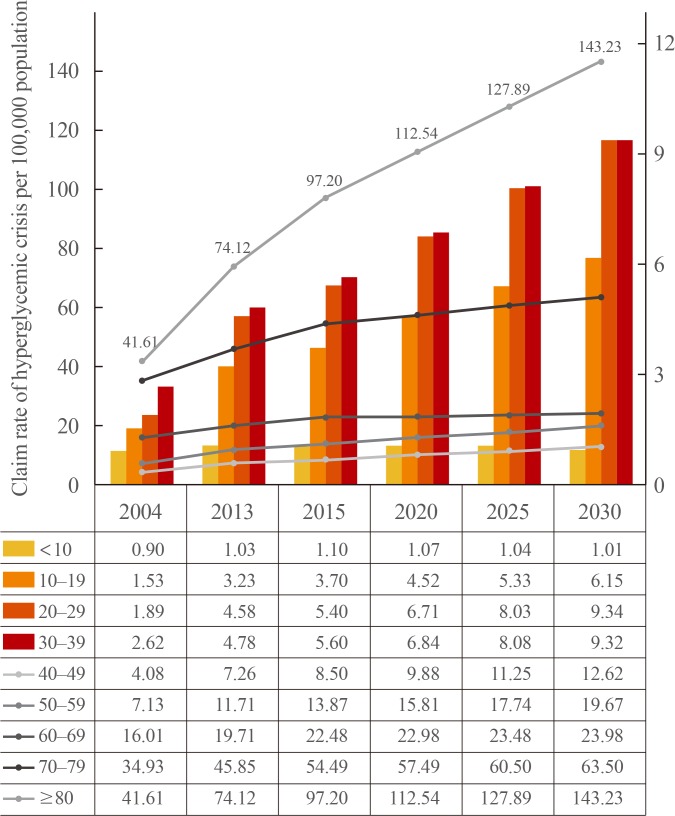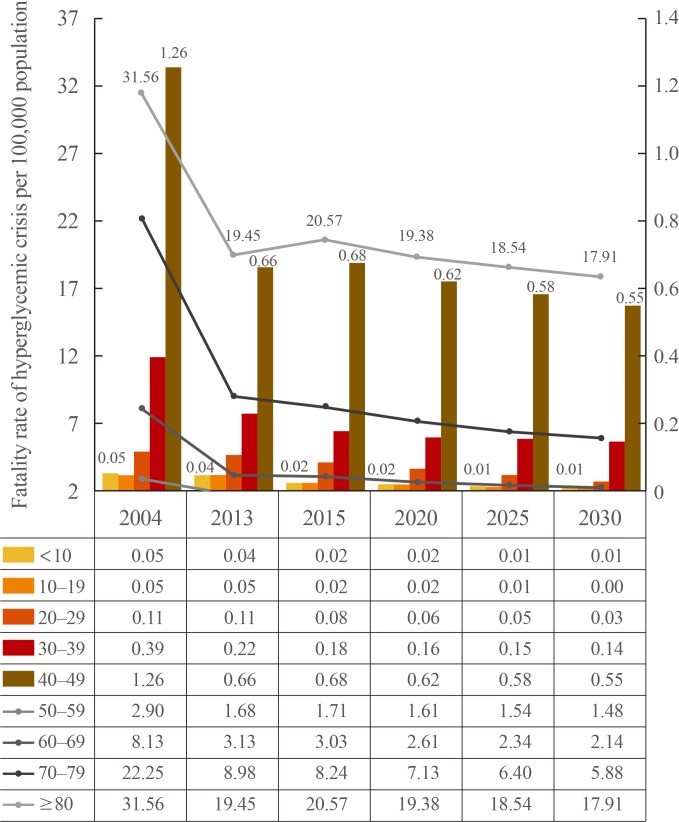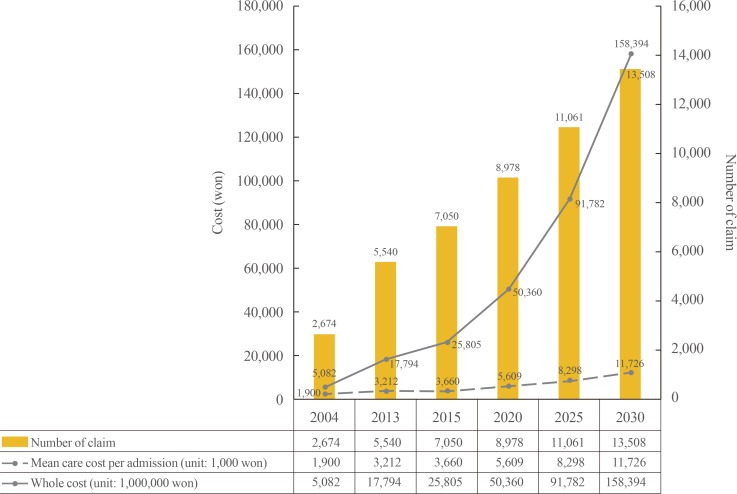Endocrinol Metab.
2019 Sep;34(3):275-281. 10.3803/EnM.2019.34.3.275.
Trends in Hyperglycemic Crisis Hospitalizations and in- and out-of-Hospital Mortality in the Last Decade Based on Korean National Health Insurance Claims Data
- Affiliations
-
- 1Division of Endocrinology and Metabolism, Department of Internal Medicine, National Health Insurance Service Ilsan Hospital, Goyang, Korea. songso@nhimc.or.kr
- 2Department of Policy Research Affairs, National Health Insurance Service Ilsan Hospital, Goyang, Korea.
- 3Division of Endocrinology and Metabolism, Department of Internal Medicine, Chung-Ang University College of Medicine, Seoul, Korea.
- 4Department of Internal Medicine, Inje University Ilsan Paik Hospital, Inje University College of Medicine, Goyang, Korea.
- 5Division of Endocrinology and Metabolism, Department of Internal Medicine, Severance Hospital, Yonsei University College of Medicine, Seoul, Korea.
- KMID: 2458630
- DOI: http://doi.org/10.3803/EnM.2019.34.3.275
Abstract
- BACKGROUND
Hyperglycemic crisis is a metabolic emergency associated with diabetes mellitus. However, accurate epidemiologic information on cases of hyperglycemic crisis in Korea remains scarce. We evaluated trends in hyperglycemic crisis hospitalizations and in- and out-of-hospital mortality in Korea. We also predicted future trends.
METHODS
We extracted claims data with hyperglycemic crisis as the principal diagnosis from the National Health Insurance Service database in Korea from January 2004 to December 2013. We investigated the numbers of claims with hyperglycemic crisis and identified trends in hyperglycemic crisis based on those claims data. We predicted future trends by statistical estimation.
RESULTS
The total annual number of claims of hyperglycemic crisis increased from 2,674 in 2004 to 5,540 in 2013. Statistical analysis revealed an increasing trend in hyperglycemic crisis hospitalizations (P for trend <0.01). In contrast, the hospitalization rate per 1,000 diabetes cases showed a decreasing trend (P for trend <0.01) during this period. The mortality rate per 1,000 diabetes cases also showed a decreasing trend (P for trend <0.0001). However, no distinct linear trend in the case-related fatality rate at <60 days over the last decade was observed. The predicted number of annual claims of hyperglycemic crisis will increase by 2030.
CONCLUSION
The number of hyperglycemic crisis hospitalizations in Korea increased in the last decade, although the hospitalization rate per 1,000 diabetes cases and mortality rate decreased. Also, the predicted number of annual claims will increase in the future. Thus, it is necessary to establish long-term healthcare policies to prevent hyperglycemic crisis.
Keyword
MeSH Terms
Figure
Cited by 1 articles
-
Acute Hyperglycemic Crises with Coronavirus Disease-19: Case Reports
Na-young Kim, Eunyeong Ha, Jun Sung Moon, Yong-Hoon Lee, Eun Young Choi
Diabetes Metab J. 2020;44(2):349-353. doi: 10.4093/dmj.2020.0091.
Reference
-
1. Huang CC, Weng SF, Tsai KT, Chen PJ, Lin HJ, Wang JJ, et al. Long-term mortality risk after hyperglycemic crisis episodes in geriatric patients with diabetes: a national population-based cohort study. Diabetes Care. 2015; 38:746–751. PMID: 25665811.
Article2. Wolfsdorf J, Glaser N, Sperling MA. American Diabetes Association. Diabetic ketoacidosis in infants, children, and adolescents: a consensus statement from the American Diabetes Association. Diabetes Care. 2006; 29:1150–1159. PMID: 16644656.3. Benoit SR, Zhang Y, Geiss LS, Gregg EW, Albright A. Trends in diabetic ketoacidosis hospitalizations and in-hospital mortality: United States, 2000–2014. MMWR Morb Mortal Wkly Rep. 2018; 67:362–365. PMID: 29596400.4. Malone ML, Gennis V, Goodwin JS. Characteristics of diabetic ketoacidosis in older versus younger adults. J Am Geriatr Soc. 1992; 40:1100–1104. PMID: 1401693.
Article5. Ramaesh A. Incidence and long-term outcomes of adult patients with diabetic ketoacidosis admitted to intensive care: a retrospective cohort study. J Intensive Care Soc. 2016; 17:222–233. PMID: 28979495.
Article6. Pasquel FJ, Umpierrez GE. Hyperosmolar hyperglycemic state: a historic review of the clinical presentation, diagnosis, and treatment. Diabetes Care. 2014; 37:3124–3131. PMID: 25342831.
Article7. Kim S. Burden of hospitalizations primarily due to uncontrolled diabetes: implications of inadequate primary health care in the United States. Diabetes Care. 2007; 30:1281–1282. PMID: 17290038.8. Kitabchi AE, Umpierrez GE, Miles JM, Fisher JN. Hyperglycemic crises in adult patients with diabetes. Diabetes Care. 2009; 32:1335–1343. PMID: 19564476.
Article9. O'Shea M, Teeling M, Bennett K. The prevalence and ingredient cost of chronic comorbidity in the Irish elderly population with medication treated type 2 diabetes: a retrospective cross-sectional study using a national pharmacy claims database. BMC Health Serv Res. 2013; 13:23. PMID: 23324517.10. Song SO, Lee YH, Kim DW, Song YD, Nam JY, Park KH, et al. Trends in diabetes incidence in the last decade based on Korean National Health Insurance claims data. Endocrinol Metab (Seoul). 2016; 31:292–299. PMID: 27302715.
Article11. Wang J, Geiss LS, Williams DE, Gregg EW. Trends in emergency department visit rates for hypoglycemia and hyperglycemic crisis among adults with diabetes, United States, 2006–2011. PLoS One. 2015; 10:e0134917. PMID: 26252486.
Article12. Ko SH, Lee WY, Lee JH, Kwon HS, Lee JM, Kim SR, et al. Clinical characteristics of diabetic ketoacidosis in Korea over the past two decades. Diabet Med. 2005; 22:466–469. PMID: 15787674.
Article13. Abdulrahman GO, Amphlett B, Okosieme OE. Trends in hospital admissions with diabetic ketoacidosis in Wales, 1999–2010. Diabetes Res Clin Pract. 2013; 100:e7–e10. PMID: 23380135.
Article14. Lombardo F, Maggini M, Gruden G, Bruno G. Temporal trend in hospitalizations for acute diabetic complications: a nationwide study, Italy, 2001–2010. PLoS One. 2013; 8:e63675. PMID: 23717464.
Article15. Liu CC, Chen KR, Chen HF, Huang HL, Ko MC, Li CY. Trends in hospitalization for diabetic ketoacidosis in diabetic patients in Taiwan: analysis of national claims data, 1997–2005. J Formos Med Assoc. 2010; 109:725–734. PMID: 20970069.
Article16. Wang J, Williams DE, Narayan KM, Geiss LS. Declining death rates from hyperglycemic crisis among adults with diabetes, U.S., 1985–2002. Diabetes Care. 2006; 29:2018–2022. PMID: 16936146.
Article17. Venkatesh B, Pilcher D, Prins J, Bellomo R, Morgan TJ, Bailey M. Incidence and outcome of adults with diabetic ketoacidosis admitted to ICUs in Australia and New Zealand. Crit Care. 2015; 19:451. PMID: 26715333.
Article18. Henriksen OM, Roder ME, Prahl JB, Svendsen OL. Diabetic ketoacidosis in Denmark incidence and mortality estimated from public health registries. Diabetes Res Clin Pract. 2007; 76:51–56. PMID: 16959363.19. Song SO, Song YD, Nam JY, Park KH, Yoon JH, Son KM, et al. Epidemiology of type 1 diabetes mellitus in Korea through an investigation of the national registration project of type 1 diabetes for the reimbursement of glucometer strips with additional analyses using claims data. Diabetes Metab J. 2016; 40:35–45. PMID: 26912154.
Article20. Jeon JY, Kim SK, Kim KS, Song SO, Yun JS, Kim BY, et al. Clinical characteristics of diabetic ketoacidosis in users and non-users of SGLT2 inhibitors. Diabetes Metab. 2019; 1. 09. [Epub]. DOI: 10.1016/j.diabet.2019.01.001.
Article
- Full Text Links
- Actions
-
Cited
- CITED
-
- Close
- Share
- Similar articles
-
- Response: Trends in Hyperglycemic Crisis Hospitalizations and in- and out-of-Hospital Mortality in the Last Decade Based on Korean National Health Insurance Claims Data (Endocrinol Metab 2019;34:275–81, Ji Hong You et al.)
- Letter: Trends in Hyperglycemic Crisis Hospitalizations and in- and out-of-Hospital Mortality in the Last Decade Based on Korean National Health Insurance Claims Data (Endocrinol Metab 2019;34:275–81, Ji Hong You et al.)
- Sensitivity of Medical Insurance Claims Data Using Population-based Cancer Registry Data
- Obesity and 30-day case fatality after hyperglycemic crisis hospitalizations in Korea: a national cohort study
- The Trend of Risk-adjusted Hospital Mortality Rates of Coronary Artery Bypass Graft Patients from 2001 to 2003




